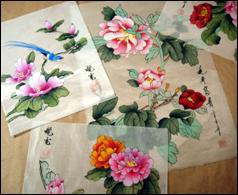 Photo 1
Photo 1
Hand painted silks are inexpensive collectibles available on the streets, in tourist shops, and at airports kiosks. Often priced between $5.00 - $10.00 US they are very popular keepsakes from a trip to China.
With all corners of the globe having become tourist destinations, custom framers are regularly presented with inexpensive collectibles and keepsakes from afar. How do we mount leather shadow puppets from Bali; molas from South America; scherenschnitte (papercuts) from Germany; or silk paintings from Asia? The battle cries of "just do no harm" and "preservation, preservation" will forever remain the demands of fine professional custom framers, but alas, many times customers demand a real world inexpensive approach for framing their things rather than a museum format.
Hand painted Chinese silk pictures may be inexpensive, unmounted, collectibles available on street corners, in tourist shops, and at airports kiosks. Often priced between $5.00 - $10.00 USD they are very popular keepsakes from a trip to China (photo 1). So on my latest trip to the Orient this past December I purchased a few small silk paintings for basic testing, handling abuse, and to help their determine framing tolerances, from a real world point of view.
 Photo 1
Photo 1
Hand painted silks are inexpensive collectibles available on the streets, in tourist shops, and at airports kiosks. Often priced between $5.00 - $10.00 US they are very popular keepsakes from a trip to China.
Sampler of Silks
The history of silk production and trading in Asia traces back thousands of years, across the continent West to India, and farther East into Japan. China has been credited with the development of silk worm farms, silk fabric production, silk embroidery, and both calligraphy and painting on silk for centuries. By 1979 the two oldest silk paintings to date had been found in the tombs at Changsha, Hunan dating from the late Warring States Period (circa 220BC) during the Han Dynasty.
The Conservation Approach
While discussing history I want to compare the correct conservation approach to dealing with valuable silk paintings vs. inexpensive yet sentimental paintings. Textile conservators always stress the best prevention of deterioration of delicate fibers is by minimalizing intervention with the textile. There will always be a natural aging process, as with paper, but the worst causes of damage to fabrics are light, pollution, heat, moisture, cleaning, excessive handling, mishandling, and bad storage systems. The best presentation for a displayed collectible silk painting would be at a low light level of 50 lux; keeping windows covered; in a room of 56-58—F; at 50-60% relative humidity; with UV glazing. Sounds a bit like a museum setting and perhaps not real world living for many customers.
Standard preservation practices for all textiles no matter the value should always include wearing cotton gloves when handling; lying the silk painting flat on a clean covered surface to examine and work on; never dragging or pulling the silk which might stress threads; and always carefully inspecting it for previous repairs or restorations. When a collectible silk painting is brought in for framing, a thorough condition report should always be filled out with the customer at the time of presentation. It is imperative the customer be shown all of the idiosyncrasies and peculiarities of their specific silk painting, prior to final framing for later reference if necessary.
Cleaning
Cleaning of textiles is a very sensitive practice and should only be attempted by a reputable textile conservator. There are wet, dry and vacuuming methods, none of which are appropriate for delicate unmounted silk paintings. The most noninvasive way to clean heavier textiles such as tapestries and clothing may often be vacuuming. The textile should be covered with a net screen (fiberglass) to prevent pieces from being sucked into the vacuum, and the vacuum head should also be covered with the same type of screen. Never use pressure nor a brush attachment when vacuuming.
Silk, Paper and Pigment
Poetry, calligraphy and painting are three of the most respected arts in China. Both silk and paper are used for calligraphy and painting, but there are significant differences between them. Since scroll mounting remains the mounting option of choice for traditional Chinese art, handmade Chinese papers that are unsized enable the painted pigment to attach aggressively to the paper fibers. Unlike their European counterparts, Chinese watercolors are ground pigment suspended in water with glue added as a fixative. The Chinese use both translucent watercolors and opaque gouache for painting. Inks are made from the collection of soot prepared by the partial combustion of fats and oils, making them carbon based. Chinese watercolors and inks will soak into unsized papers allowing for them to become water resistant for later scroll mounting.
The above water resistant paints and inks used during the painting of traditional high end painting on paper are also used with silk, but the silk has generally been sized. This allows for the finite and meticulous detailing in paintings rather than the free flowing non-detailed images often seen on unsized papers. Sizing is what often gives contemporary silk paintings a crackly paper-like appearance. But all silks are not created equal.
Types of Silk for Painting
Inexpensive contemporary silk paintings are a dime a dozen these days for tourists. Though they feel and sound much like paper they are indeed silk fabric and not paper backed silk as is used in scroll mounting (refer to detail photo 4). The painted silks in photo 2 showcase three different commercial types. Far left is a white, hard surfaced, shiny silk; center is an antique white, softer fabric; far right is an antique white, nonglossy, hard surfaced silk that most resembles the feel of paper.
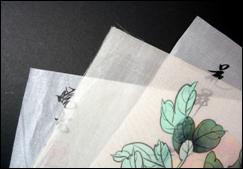 Photo 2
Photo 2
Hand painted silks are inexpensive collectibles available on the streets, in tourist shops, and at airports kiosks. Often priced between $5.00 - $10.00 US they are very popular keepsakes from a trip to China.
Types of Silk
Far left is a white, hard surfaced, shiny silk; center is an antique white, softer silk; far right is an antique white, non-glossy, hard surfaced silk that most resembles the feel of paper.
Identification of the art as real silk or synthetic can determine how it may be mounted for framing. Real silk tolerates exposure to heat, water and adhesives much better than synthetics do. The easiest way to determine whether the painting is real silk or not is to pull one or two threads from the raveled edge and do a burn test. Painting fabrics are often slightly frayed at the edges so the acquiring of a few cast of threads is often easy to achieve.
Natural raw silk or silk blends will burn down the thread much like a candle wick leaving the burnt fiber. Linen burns down the thread but leaves a powdered ash where the thread was, and polyester silk will melt into a glob (photo 3). Real silk will either totally incinerate into ash and disappear, or recoil into a tiny burnt stub (photo 4). Knowing what exact type of silk fabric you are dealing with may help the decision as to the mounting process...that and what the customer may have paid for the sampler and is willing to invest in framing.
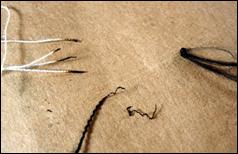 Photo 3: Silk from Synthetic
Photo 3: Silk from Synthetic
(L to R) Natural raw silk or silk blends will burn down the thread much like a candle wick leaving the burnt fiber. Linen burns down the thread but leaves a powdered ash where the thread was, and polyester silk will melt into a glob.
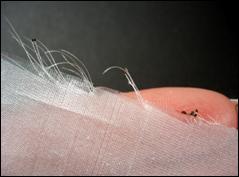 Photo 4: Real Silk
Photo 4: Real Silk
Real silk will either totally incinerate into ash and disappear, or recoil into a tiny burnt stub. This detail photo also shows the tiny sized threads of the silk with no backing paper, as mentioned earlier in the article.
Wet Stretching and Dry Flattening
As much as tourists care for their treasures, accidents happen. A badly stored or transported silk painting may become crumpled, crushed or creased (photo 5). The sizing and pigments selected in silk paintings is what allows it to hold a crush like paper. Soft fabric might tolerate warm pressing with an iron and cover cloth, but be careful of creating harder creases in sized fabrics.
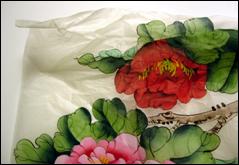 Photo 5: Crumpled, Crushed or Creased
Photo 5: Crumpled, Crushed or Creased
A badly stored or transported silk painting may become crumpled, crushed or creased. This sampler was deliberately hand crushed. The sizing in the silk allows it to hold a crush like paper.
If the paint is traditional glue based Chinese watercolor it may be totally saturated with water and flattened onto an acrylic (Plexiglas) covered table top to dry flat (photo 6). Wet flattening requires total saturation of the entire painting, not just the crushed portion. In photo 7 notice two things: the fingers at the edge, the dry center portion of the silk. Once soaked the silk will easily wet adhere to the acrylic table and by lightly pulling the silk along all edges with your fingertips it is tightens and flattens against the smooth table to dry.
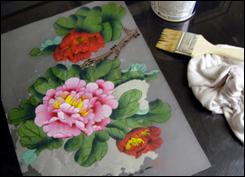 Photo 6: Wet to Flatten
Photo 6: Wet to Flatten
If the paint is traditional glue based water resistant paint it may be totally saturated with water on an acrylic (Plexiglas) covered table top and allowed to dry flat. Wet flattening requires total saturation.
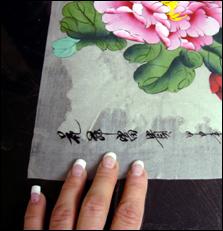 Photo 7: Wet Stretched
Photo 7: Wet Stretched
Lightly bump the wet silk at the outer edges with your fingertips to wet stretch. The dry upper portion of the painting will dry a different color and should also have been wet.
It is important when wet stretching a sheer piece of painted silk that the entire piece be soaked or the inner dry portion will dry lighter and with a different texture. This may have to do with the sizing in the silk or the inexpensive paints used for inexpensive paintings. You must also test all the colors to verify they are indeed waterfast and not likely to run or bleed.
This particular painting did lightly draw out some of the color, not bleeding, but color intensity thinning, mostly in the yellow stamen. It would not be in the best interest of this $10. sampler to wet stretch it to flatten. Later you will see dry mounting is a perfect solution.
Natural Cockling
There was a recent discussion on PPFA Hitchhikers concerning a large 30x40" rolled and wrinkled silk painting. If this was a piece of fine art which used traditional Chinese watercolors and not European watercolors (no fixatives) it could have been dry ironed or wet flattened as above. Not knowing generally will opt for the least invasive method of handling.
When paint is applied to sheer sized silk it will naturally lightly ripple or cockle as does western watercolor paper or thin rice paper, some silks worse than others (photo 8). The excessive shiny nature of the highly sized painting makes it resistant to absorption resulting in cockling. Depending on the amount and consistency of paint and the silk itself, the painting will often appear cockled if placed hinged in a window mat with pressure at the edges (photo 9). No amount of pressure at the edges of a window mat will ever hold down or smooth out the natural cockles created by dense opaque paint and sized silk.
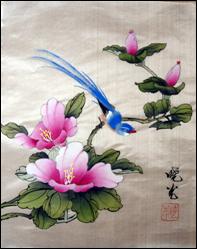 Photo 8: Shiny with Natural Cockle
Photo 8: Shiny with Natural Cockle
The excessive shiny nature of the highly sized painting and very resistant to absorption resulting in cockling.
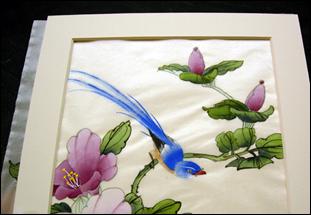 Photo 9: Window Mat Pressure
Photo 9: Window Mat Pressure
No amount of pressure at the edges of a window mat will hold down or smooth out the natural cockles created by dense opaque paint and sized silk.
Other Mounting Options
An unmounted silk painting is not the same as a soft, unsized, hemmed silk scarf. Techniques including pressure stretching; encapsulating a painting between two pieces of glass or in a polyester sleeve; or static mounting will never make it or keep it flat. Other mounting options for silk paintings could be lacing; pinning; nonpreservation wet adhesive mounting, and dry mounting.
Stretching
Lacing would not be any better an option for silk paintings than stretch pinning. The silk is sheer and the fibers could easily split. Pressure stretching is the tucking of the edges of the painting around a straight blunt cut edge of a foam center or museum board fallout then refitting it back into the window creating a pressure hold.
The problem again is the possible crinkling of the edges if a clean hospital corner may be achievable resulting from sizing stiffness of the silk. Paintings must be able to tolerate the pulling required to adjust a pressure mount once the fallout has been reinserted.
Wet Glue
Check water resistance levels of the paint when selecting wet adhesives. What I have noticed is a significant difference in the quality of the paints used in these inexpensive silk paintings. Whereas the high end silks of fine Asian art are waterproof and readily tolerate the extreme application of water saturation required during the traditional scroll mounting process, these inexpensive paintings do not have the same tolerances.
Dry Mounting
Low end (and probably high end) paintings quite easily dry mount safely at lower temperatures. It may be more a matter of should it be mounted, rather than can it be mounted. The low temperature heat activated boards, like SpeedMount and Single Step Plus, nicely flatten and mount these silk paintings (photo 10). SpeedMount was used for this particular sample, with only the right half of the silk having been mounted. It was bonded in a mechanical press of 155ºF for 30 seconds and cooled under a weight. The reversible dry mount HA board Artcare Restore would also be a good choice.
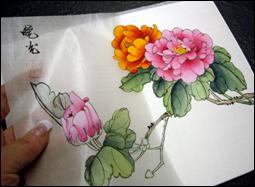 Photo 10: Dry Mounted
Photo 10: Dry Mounted
SpeedMount was used for this sample, with only the right half of the silk having been mounted. It was bonded in a mechanical press of 155ºF for 30 seconds and cooled under a weight.
Substrate Selection
Since HA low temperature boards are only available in white and black, color selection of a substrate to control color ghosting or bleeding is limited. The paintings are sheer, translucent, and will easily ghost any substrate color through to alter the color of the original painting (photo 11). Selection of the adhesive will also impact the end color, so think first.
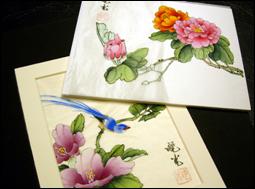 Photo 11: Substrate Selection
Photo 11: Substrate Selection
The paintings are sheer, translucent, and will easily ghost any substrate color through to alter the color of the original painting. Both of these are antique white silk paintings that have been shifted to crème and white by the selection of the substrate.
In like turn, selecting a mount board of color contrast can also color enhance through tinting the over all painting (photo 12). Black, white and creme are shown in the photo, but blue, pink or green could intensify and alter the original painting colors and look.
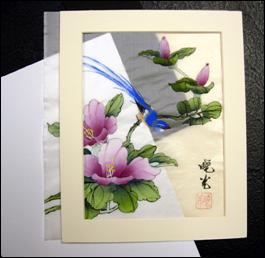 Photo 12: Color Tinting
Photo 12: Color Tinting
Selecting a mount board with a color contrast can also color enhance through tinting the over all painting. Black, white and crème are shown in the photo, but blue, pink or green would intensify and yes, change the original painting colors.
What to Do, What not to Do
So if it can't be sewn, laced, pinned, stretched, wet, steamed, ironed, static mounted, encapsulated in polyester, or traditionally scroll mounted, what can be done? Perhaps it can be pressure mounted, dry mounted, hinged (with a few remaining ripples), dry mounted, or dry mounted. No, this is not a preservation method, but again, these may very well be $5.00 paintings.
Expensive high end, fine art silk painting collectibles will properly already be scroll mounted. Then it's a matter of how to encase them...in an acrylic box or deep shadow box frame.
END
Copyright © 2005 Chris A Paschke
For more articles on mounting basics look under the mounting section in Articles by Subject.
Additional information on all types of mounting is found in:
The Mounting and Laminating Handbook, Second Edition, 2002,
The Mounting And Laminating Handbook, Third Edition, 2008 and
Creative Mounting, Wrapping, And Laminating, 2000 will teach you everything you need to know about getting the most from your dry mount equipment and materials as an innovative frame designer.
All books are available from Designs Ink Publishing through this website.
Chris A Paschke, CPF GCF
Designs Ink
Designs Ink Publishing
785 Tucker Road, Suite G-183
Tehachapi, CA 93561
P 661-821-2188
chris@designsinkart.com